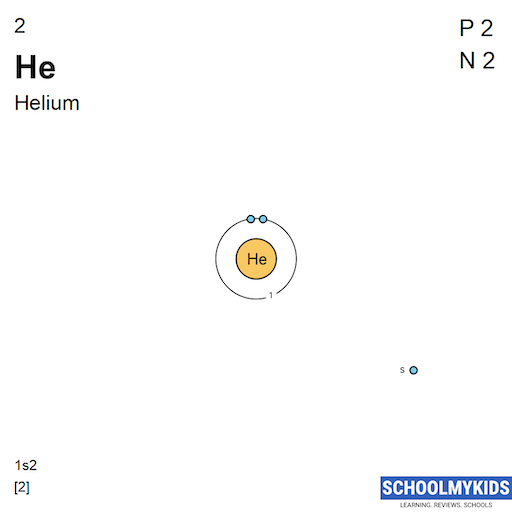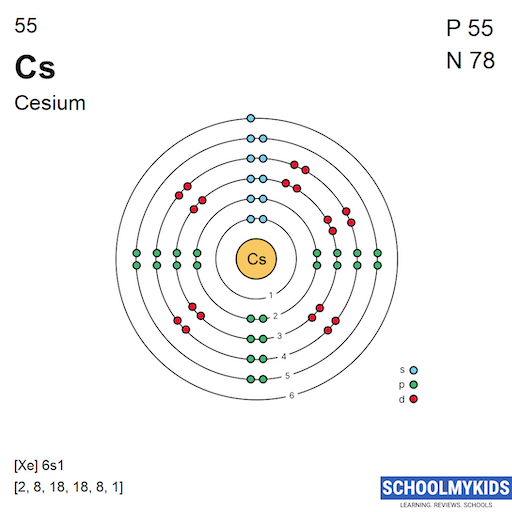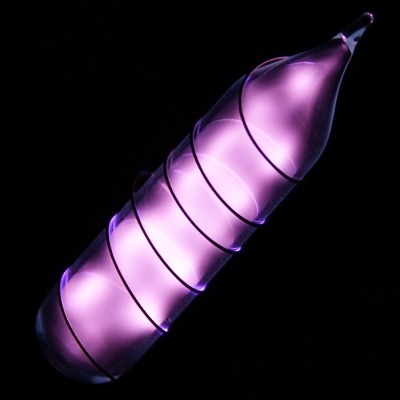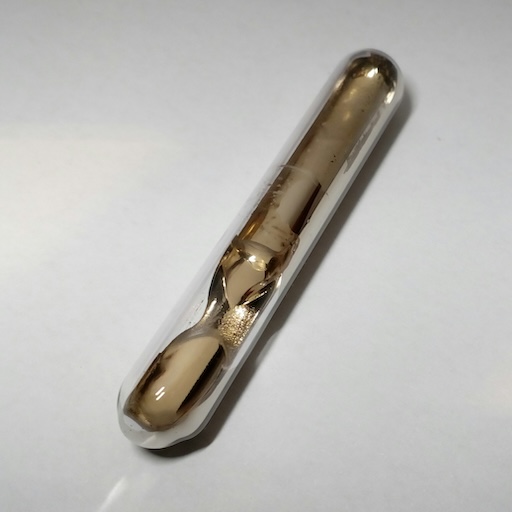Periodic Table Element Comparison: Compare Elements - Helium vs Cesium
Compare Helium and Cesium
Compare Helium and Cesium on the basis of their properties, attributes and periodic table facts. Compare elements on more than 90 properties. All the elements of similar categories show a lot of similarities and differences in their chemical, atomic, physical properties and uses. These similarities and dissimilarities should be known while we study periodic table elements. You can study the detailed comparison between Helium vs Cesium with most reliable information about their properties, attributes, facts, uses etc. You can compare He vs Cs on more than 90 properties like electronegativity , oxidation state, atomic shells, orbital structure, Electronaffinity, physical states, electrical conductivity and many more.
Facts
| Name | Helium | Cesium |
| Atomic Number | 2 | 55 |
| Atomic Symbol | He | Cs |
| Atomic Weight | 4.002602 | 132.90545 |
| Phase at STP | Gas | Solid |
| Color | Colorless | Silver |
| Metallic Classification | Noble Gas | Alkali Metal |
| Group in Periodic Table | group 18 | group 1 |
| Group Name | helium family or neon family | lithium family |
| Period in Periodic Table | period 1 | period 6 |
| Block in Periodic Table | p -block | s -block |
| Electronic Configuration | 1s2 | [Xe] 6s1 |
| Electronic Shell Structure (Electrons per shell) | 2 | 2, 8, 18, 18, 8, 1 |
| Melting Point | 0 K | 301.59 K |
| Boiling Point | 4.22 K | 944 K |
| CAS Number | CAS7440-59-7 | CAS7440-46-2 |
| Neighborhood Elements | Neighborhood Elements of Helium | Neighborhood Elements of Cesium |
History
| Name | Helium | Cesium |
| History | The element Helium was discovered by P. Janssen and N. Lockyer in year 1868 in Sweden and United Kingdom. Helium derived its name from the Greek word helios, meaning 'sun'. | The element Cesium was discovered by R. Bunsen and R. Kirchhoff in year 1860 in Germany. Cesium derived its name from the Latin caesius, meaning 'sky blue'. |
| Discovery | P. Janssen and N. Lockyer (1868) | R. Bunsen and R. Kirchhoff (1860) |
| Isolated | W. Ramsay,T. Cleve, and N. Langlet (1895) | C. Setterberg (1882) |
Presence: Abundance in Nature and Around Us
Parts per billion (ppb) by weight / by atoms (1ppb =10^-7 %)
| Name | Helium | Cesium |
| Abundance in Universe | 230000000 / 72000000 | 0.8 / 0.01 |
| Abundance in Sun | 230000000 / 74000000 | 8 / 0.07 |
| Abundance in Meteorites | - / - | 140 / 20 |
| Abundance in Earth's Crust | 5.5 / 30 | 1900 / 290 |
| Abundance in Oceans | 0.0072 / 0.011 | 0.5 / 0.023 |
| Abundance in Humans | - / - | 20 / 1 |
Crystal Structure and Atomic Structure
| Name | Helium | Cesium |
| Atomic Volume | 22.4136 cm3/mol | 70.732 cm3/mol |
| Atomic Radius | 31 pm | 298 pm |
| Covalent Radius | 32 pm | 225 pm |
| Van der Waals Radius | 140 pm | 343 pm |
| Atomic Spectrum - Spectral Lines | ||
| Emission Spectrum |  |  |
| Absorption Spectrum |  | Not available |
| Lattice Constant | 424.2, 424.2, 424.2 pm | 614.1, 614.1, 614.1 pm |
| Lattice Angle | π/2, π/2, π/2 | π/2, π/2, π/2 |
| Space Group Name | Fm_ 3m | Im_ 3m |
| Space Group Number | 225 | 229 |
| Crystal Structure | Face Centered Cubic  | Body Centered Cubic  |
Atomic and Orbital Properties
| Name | Helium | Cesium |
| Atomic Number | 2 | 55 |
| Number of Electrons (with no charge) | 2 | 55 |
| Number of Protons | 2 | 55 |
| Mass Number | 4.002602 | 132.90545 |
| Number of Neutrons | 2 | 78 |
| Shell structure (Electrons per energy level) | 2 | 2, 8, 18, 18, 8, 1 |
| Electron Configuration | 1s2 | [Xe] 6s1 |
| Valence Electrons | 1s2 | 6s1 |
| Oxidation State | - | 1 |
| Atomic Term Symbol (Quantum Numbers) | 1S0 | 2S1/2 |
| Shell structure |  |  |
Isotopes and Nuclear Properties
Helium has 2 stable naturally occuring isotopes while Cesium has 1 stable naturally occuring isotopes.
| Name | Helium | Cesium |
| Known Isotopes | 3He, 4He, 5He, 6He, 7He, 8He, 9He, 10He | 112Cs, 113Cs, 114Cs, 115Cs, 116Cs, 117Cs, 118Cs, 119Cs, 120Cs, 121Cs, 122Cs, 123Cs, 124Cs, 125Cs, 126Cs, 127Cs, 128Cs, 129Cs, 130Cs, 131Cs, 132Cs, 133Cs, 134Cs, 135Cs, 136Cs, 137Cs, 138Cs, 139Cs, 140Cs, 141Cs, 142Cs, 143Cs, 144Cs, 145Cs, 146Cs, 147Cs, 148Cs, 149Cs, 150Cs, 151Cs |
| Stable Isotopes | Naturally occurring stable isotopes: 3He, 4He | Naturally occurring stable isotopes: 133Cs |
| Neutron Cross Section | 0.007 | 29 |
| Neutron Mass Absorption | 0.00001 | 0.0077 |
Chemical Properties: Ionization Energies and electron affinity
| Name | Helium | Cesium |
| Valence or Valency | 0 | 1 |
| Electronegativity | - | 0.79 Pauling Scale |
| Electron Affinity | 0 kJ/mol | 45.5 kJ/mol |
| Ionization Energies | 1st: 2372.3 kJ/mol 2nd: 5250.5 kJ/mol | 1st: 375.7 kJ/mol 2nd: 2234.3 kJ/mol 3rd: 3400 kJ/mol |
Physical Properties
| Name | Helium | Cesium |
| Density | 0.0001785 g/cm3 | 1.879 g/cm3 |
| Molar Volume | 22.4136 cm3/mol | 70.732 cm3/mol |
Elastic Properties | ||
| Young Modulus | - | 1.7 |
| Shear Modulus | - | - |
| Bulk Modulus | - | 1.6 GPa |
| Poisson Ratio | - | - |
Hardness - Tests to Measure of Hardness of Element | ||
| Mohs Hardness | - | 0.2 MPa |
| Vickers Hardness | - | - |
| Brinell Hardness | - | 0.14 MPa |
Electrical Properties | ||
| Electrical Conductivity | - | 5000000 S/m |
| Resistivity | - | 2e-7 m Ω |
| Superconducting Point | - | - |
Heat and Conduction Properties | ||
| Thermal Conductivity | 0.1513 W/(m K) | 36 W/(m K) |
| Thermal Expansion | - | - |
Magnetic Properties | ||
| Magnetic Type | Diamagnetic | Paramagnetic |
| Curie Point | - | - |
| Mass Magnetic Susceptibility | -5.9e-9 m3/kg | 2.8e-9 m3/kg |
| Molar Magnetic Susceptibility | -2.36e-11 m3/mol | 3.72e-10 m3/mol |
| Volume Magnetic Susceptibility | -1.05e-9 | 0.00000526 |
Optical Properties | ||
| Refractive Index | 1.000035 | - |
Acoustic Properties | ||
| Speed of Sound | 970 m/s | - |
Thermal Properties - Enthalpies and thermodynamics
| Name | Helium | Cesium |
| Melting Point | 0 K | 301.59 K |
| Boiling Point | 4.22 K | 944 K |
| Critical Temperature | 5.19 K | 1938 K |
| Superconducting Point | - | - |
Enthalpies | ||
| Heat of Fusion | 0.02 kJ/mol | 2.09 kJ/mol |
| Heat of Vaporization | 0.083 kJ/mol | 65 kJ/mol |
| Heat of Combustion | - | - |
Regulatory and Health - Health and Safety Parameters and Guidelines
| Name | Helium | Cesium |
| CAS Number | CAS7440-59-7 | CAS7440-46-2 |
| RTECS Number | RTECSMH6520000 | RTECSFK9225000 |
| DOT Hazard Class | 2.2 | 4.3 |
| DOT Numbers | 1963 | 1407 |
| EU Number | - | - |
| NFPA Fire Rating | 0 | - |
| NFPA Health Rating | 1 | - |
| NFPA Reactivity Rating | 0 | - |
| NFPA Hazards | - | Water Reactive |
| AutoIgnition Point | - | - |
| Flashpoint | - | - |
Compare With Other Elements
Compare Helium with all Group 18 elementsCompare Helium with all Period 1 elementsCompare Helium with all Noble Gas elements | Compare Cesium with all Group 1 elementsCesium vs LithiumCesium vs HydrogenCesium vs SodiumCesium vs PotassiumCesium vs RubidiumCesium vs Francium Compare Cesium with all Period 6 elementsCesium vs PraseodymiumCesium vs BariumCesium vs LanthanumCesium vs CeriumCesium vs NeodymiumCesium vs PromethiumCesium vs SamariumCesium vs EuropiumCesium vs GadoliniumCesium vs TerbiumCesium vs DysprosiumCesium vs HolmiumCesium vs ErbiumCesium vs ThuliumCesium vs YtterbiumCesium vs LutetiumCesium vs HafniumCesium vs TantalumCesium vs TungstenCesium vs RheniumCesium vs OsmiumCesium vs IridiumCesium vs PlatinumCesium vs GoldCesium vs MercuryCesium vs ThalliumCesium vs LeadCesium vs BismuthCesium vs PoloniumCesium vs AstatineCesium vs Radon Compare Cesium with all Alkali Metal elements |


